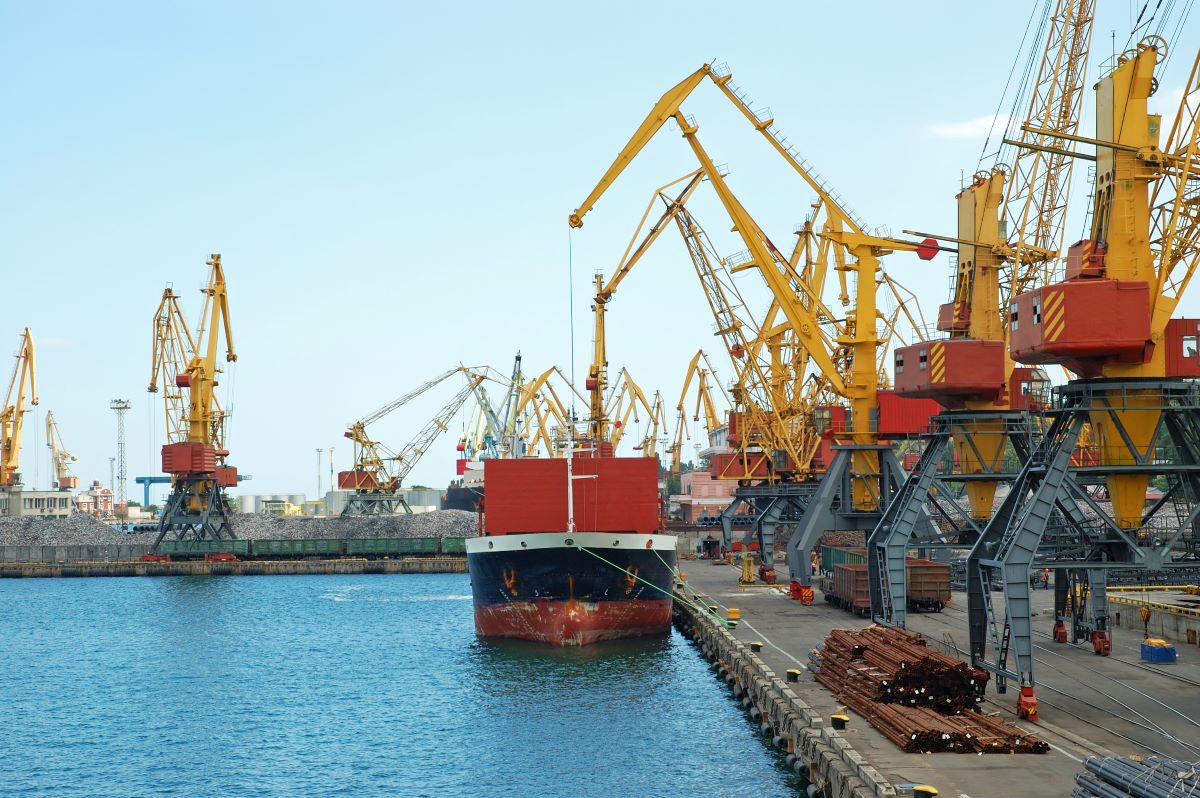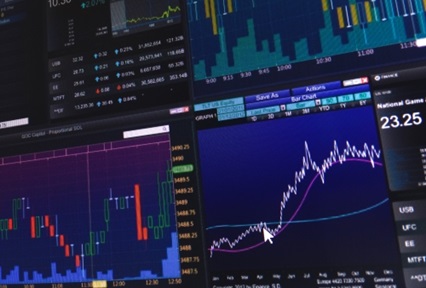Development of smart ports in Africa
An opportunity for Singapore to step in
By Mandira Bagwandeen

Introduction
Ports have to constantly deal with ever-changing freight traffic flows, environmental concerns, operational hazards, and abrupt supply chain disruptions such as the ones witnessed recently following the outbreak of the Covid-19 pandemic. Many are upgrading to become “smart ports.” A smart port is an automated port that uses data analytics to make the best decisions possible and run operations effectively. It is said to be “more effective, more performant and more economically competitive.”[1] A port is considered ‘smart’ when it replaces manual operations with automation and achieves operational efficiencies by adopting paperless, clean, and connected digital technology in managing its operations.
According to Deloitte ports have gone through four phases of evolution over the past six decades. Until the 1960s, they were little more than loading and unloading facilities, with many evolving over time to become industrial ports in the 1980s. From then on, ports began transitioning to become more integrated with global and regional supply chains, hence the emergence of logistics or supply chain ports post-1980s.[2] It is only after 2010, that ‘smart ports’ began to emerge.

A smart port uses advanced technology to automate operations and improve logistics. This includes (but is not limited to) artificial intelligence (AI), Big Data, the internet of things (IoT), and Blockchain. The use of such technologies reduces accidents, and traffic disruptions, improves efficiency and lowers operational costs. Other benefits include a decrease in dwell times, improving tracking, handling capacity, and even helping to streamline customs procedures. Major international trading hubs such as Rotterdam, Hamburg, Antwerp, Los Angeles, Singapore, and Shanghai have made significant investments in turning their ports into smart ports.[4] One of the largest investments was made by Shanghai International Port Group (SIPG) in 2018. It launched a US$2.2bn automated cargo wharf at the deep-sea Yangshan Port.[5] With 90% of world trade dependent on maritime transport,[6] the development of smart ports will have a major impact on global trade.
The development of a smart port goes beyond simply adopting and applying advanced technologies. Instead, smart ports are created by “interlocking numerous information technologies and systems.”[7] These ports require the integration of information, a convergence of systems, and inter-connectivity between different systems, equipment, facilities, and business entities. This requires cooperation and partnerships with many stakeholders, such as (but not limited to) port operators, ship owners, and cargo owners.[8] There is also no one-size-fits-all approach to developing smart ports. Since the level and performance of ports vary from country to country and port to port, it is necessary to take a case-by-case approach to identify the strengths, weaknesses, and risks of applying smart port systems.[9]
Due to a growing volume of maritime trade destined for Africa, most ports on the continent need to keep improving their performance and productivity. Shifting to smart ports, which rely on automation and digitalisation to reorganise and streamline port activities, will be imperative for African countries to achieve their economic growth ambitions. Improving the efficiency and capacity of African ports is a key priority for the African Union and Regional Economic Communities, as well as organisations such as the Port Management Association of Eastern and Southern Africa (PMAESA).[10] African ports must deal with delays and backlogs due to low levels of automation. Except for Durban, cargo dwell time — the amount of time cargo spends at port — averages about 20 days in African ports, compared with three to four days at many other international ports.[11] The digitisation of ports especially gained traction in the wake of COVID-19, which impacted port operations heavily reliant on non-automated people-driven systems and functions. Many African port operators are aware of the urgent need to adopt smart strategies to remain competitive.
Smart Ports and Africa
Although some of the world’s fastest-growing economies are in Africa, the continent’s ports do not have the capacity to accommodate the growing demand for imported goods consumed by a growing African middle class. Billions of dollars of investment is required to modernise Africa’s ports if they are to handle the predicted port throughput of more than 2bn tonnes by 2040.[12] The struggle they face in handling increased cargo traffic highlights the limits of Africa’s maritime freight infrastructure.[13] Many ports in these regions are operationally inefficient, lack specialist terminal operators, and adequate inland transportation linkages. As such, high-berth occupancies are common; ships experience long holding cargo times.[14] In August 2021, the Port of Lagos, in Nigeria, experienced severe congestion, resulting in ships having to wait for up to 80 days to enter the port. Port congestion in Africa is estimated to result in millions of dollars in losses, compounding the region’s recovery from the COVID-19 pandemic.
Although Africa lags behind the rest of the world in the pace of modernisation of its ports, some have started to transform:
- In 2015, the Ghana Ports and Harbours Authority (GPHA) introduced the Terminal Operating System (TOS) at Tema Port to reduce cargo clearing time.[15] The system replaced the face-to-face meeting held thrice a week with workers to deliberate on berthing activities and tasks.[16] In 2017, the Ghana Revenue Authority (GRA) implemented the Paperless Port System at Ghana’s main ports – Tema, Takoradi, Saltpond, Sekondi, Elmina, and Accra. It reduced human interface, reduced turnaround time, and eliminated duplication of inspections by various regulatory agencies.”[17]
- As part of a pilot project, the Durban Harbour in South Africa began using drone and track-and-trace technology in October 2016.[18] Ariel and underwater drones are being used to inspect infrastructure and the condition of the seabed and collect data on port traffic. Track-and-trace technology is used to track port assets such as tugs and dredgers and provide port and terminal performance management data.[19]
- It was reported in August 2019 that digital and automation technology would be adopted to make Walvis Bay in Namibia more competitive against other ports in southern Africa.[20] Namport is introducing technology in a phased fashion, with the first phase focusing on yard management. Smart Stack, a container position recording system, is being used to reduce errors in container placement.[21] Additionally, among other automation initiatives, loading operations’ speed will increase with the use of automation software that will automatically choose the “shortest route between the container and its destination on the vessel or ground.”[22]
- In December 2021, the Nigerian Ports Authority (NPA) announced it was considering implementing ‘fully digital’ paperless port management systems across Nigeria by 2025.[23] This will require a great deal of financing and a dedicated implementation team.
- In April 2021, Tangier Med Port (also referred to as Tanger Med) in Morocco partnered with Wärtsilä, a Finnish firm, to co-develop a new Port Management and Information System (PMIS). As part of the deal, modern smart port tools, including Just In Time (JIT) solutions, machine learning, AI, and other innovative solutions, will be implemented.[24] JIT reduces the need for vessels to wait at anchorage, reducing congestion and the likelihood of collisions and decreasing greenhouse gases and carbon emissions.[25] Moreover, the new PMIS digitises the whole port call process, reducing human error and improving efficiency. An increase in the levels of data exchange is anticipated to improve operational efficiency, port safety, and environmental sustainability.[26]
Risks and Rewards
African port authorities and governments are transitioning to smart ports because of the numerous benefits of making ports “smart”, including higher productivity levels, reduced operational costs, improved security, higher safety standards, increased service levels, and improved asset utilisation.[27] Ultimately, smart port technologies link the whole port ecosystem and also enable port operators to “fluidly integrate into external partner environments: such as shippers, carriers, agents/forwarders, trucking and rail companies, customs and government bodies.”[28]

While the rewards for transitioning to smart ports are many, there are also a few risks to consider. Cybersecurity, for example, remains a potential threat. A number of high-profile cyberattacks in recent years have brought this to attention.[30] It was reported in 2013 that a drug cartel used hackers to breach IT systems at the port of Antwerp in Belgium to take control of the movement and location of containers that contained drugs.[31] Following this incident, in 2018, two major international ports –Barcelona in Spain, and the Port of San Diego, in the United States – came under cyberattack; neither of the port authorities revealed any details about the nature of the attack.[32], [33] A year earlier, the ICT network of the world’s largest shipping line, Maersk, was hit by a virus called NotPetya that targeted multiple businesses around the globe. Maersk servers in India and Europe were hit, impacting port and tug operations, drilling services, oil tankers, and container shipping. The Rotterdam Port Terminal shut down for over a week. In its report, the World Bank noted that between February and May 2020, cyberattacks increased 400% in the maritime industry.[34]
Most of Africa’s ports are unprepared for major cyberattacks. This is worrying because an incident like the 2017 Maersk virus attack on any one of the continent’s major ports – Durban, Tangier, Suez Canal, Lagos, Mombasa – would result in significant damages. African port authorities must continuously evaluate, identify, and manage risks to mitigate and prepare for potential cyberattacks.[35] Authorities also need to establish practices and processes for information technology and operational technology management. Cybersecurity training for system administrators, project managers, developers, security officers, harbour masters and other key personnel should be made mandatory. Measures are also needed to protect all systems – including desktops and servers – from malware or viruses.”[36]
Enter Singapore
Recognised as a leading international shipping hub, Singapore is often seen as a benchmark for other port cities. The Port of Singapore has been at the forefront of applying digital and automation technology to improve port performance. The container throughput in Singapore amounted to approximately 36.87 million Twenty-foot Equivalent Units (TEUs) in 2020[37], dwarfing the 6.99 million TEUs of Morocco for the same year.[38] In the 1980s, the Port of Singapore “went high-tech by introducing port operating systems like PORTNET and CITOS to streamline planning processes and operations.” [39] These systems are still used but have undergone several upgrades.
In recent years, the Maritime Port Authority of Singapore (MPA) and the Port of Singapore Authority (PSA) International, its commercial branch, have been researching new technologies that further enhance the handling capacity, productivity, and efficiency of terminals around Singapore. The Port Technology Research and Development Programme (PTRDP) aims to develop new technologies in the areas of digitalisation, automation, and robotics. In its efforts to stay at the forefront of maritime technological innovation, the MPA signed five Memorandums of Understanding (MoU) in 2017 with leading technology firms. Singapore’s Tuas Terminal – a smart mega-port project scheduled to be completed by 2040 at a cost of over US$20bn[40] will be able to handle up to 6.5m TEU containers annually.[41] It is being developed with the aim of becoming a fully automated smart port that will use green technology, drones and ship tracking on-time entry technology, and robotic technology for terminal logistics systems.[42]
The Port of Singapore Authority (PSA), and its many associated service providers, such as Jurong Port, a multi-purpose port operator; Alpha Ori, a marine data company; and ST Electronics, a defence technology firm, can look to Africa as a big market opportunity. Already, some African countries have displayed an eagerness to work with PSA. In 2015, Egypt’s Ministry of Transport signed an MoU with the PSA to operate and develop Egypt’s maritime ports.[43] More recently, in October 2020, Egyptian Transport Minister, Kamel al-Wazir, met with Dominic Goh, the Singaporean ambassador in Cairo, and PSA officials to discuss cooperation in managing and operating a multi-purpose terminal in Alexandria Port.[44] All international companies working in this sector were invited to submit their bids; the outcome at the time of writing was still pending.
The IMO-Singapore Lobito Project
In a joint venture with the International Maritime Organisation (IMO) on a pilot project to develop a digital ship clearance system at the Port of Lobito in Angola, Singapore has signalled an interest in playing a role in modernising African ports. Officially launched in November 2021, the Single Window for Facilitation of Trade (SWiFT) Project could be scaled up to benefit more African countries in the future.[45]
The SWiFT project will develop a system that enables the electronic submission of information required by various Government agencies when a ship calls at a port. This concept is known as the Maritime Single Window (MSW) system, which allows required data to be electronically submitted to customs and other relevant parties through a single portal only once.[46] It avoids duplication and ensures the efficient clearance of ships.
As part of this pilot project, Angola will be provided with legal, policy and institutional requirements for implementing the system. Under the agreement, Lobito port will receive the necessary software, hardware, and IT services from Singapore, as well as the necessary training for local officials to ensure the successful implementation of the MSW.[47]
Challenging and high-risk business environments in many parts of Africa could understandably be a deterrent for Singaporean investors. However, they can mitigate such risks through joint ventures with other overseas investors.
Competition
China has invested heavily in the development of African ports, making it the largest foreign player in the African maritime industry. Partnerships between Singaporean companies and Chinese infrastructure and maritime transport companies such as - China Merchants Port Holdings (CMHP), a subsidiary of China Merchants Group (CMG); China State Construction Engineering Corporation (CSCEC); China Harbour Engineering Company (CHEC); and China Road and Bridge Corporation (CRBC) – should be explored as these companies are not averse to operating in high-risk regions. Chinese companies can concentrate on developing the hard infrastructure, while Singapore can provide the digital and automation technology for projects.
Competitors like DP World (of Dubai) and Abu Dhabi Ports (AD Ports) are already making their presence felt. DP World is already present in ten African countries, including South Africa, Mozambique, Angola, Rwanda, Somaliland, Djibouti, Nigeria, Senegal, Algeria, and Egypt. Following a concession agreement signed in December 2020 between DP World and the Government of Senegal, the former began construction on the Port of Ndagane in January 2022. It will also operate the port once complete. With an investment of more than US$1bn, this is DP World’s biggest port investment in Africa and the largest single private investment in Senegalese history.[48]
AD Ports runs the Kamsar Container Terminal in Guinea – its only asset in Africa. But with over a billion dollars to invest, it could soon emerge as a competitor to DP World.[49] In 2021, representatives of AD Ports visited Benin, Namibia, Angola and the DRC, scouting for projects.[50] The Emirati port developer is also building alliances with shipowners and commodity traders to get “its foot in the door.” It is also taking advantage of its friendly relations with fellow Arab African countries. In November 2021, AD Ports signed an MoU with Egypt in November 2021 to build a multimodal terminal at the port of Safaga.[51]
A European investor to consider as a potential partner is the Mediterranean Shipping Company (MSC) Group. It is a privately held Swiss-Italian group that has expanded its shipping fleet significantly since the outbreak of COVID-19 in 2019/early 2020. As of December 2021, MSC representatives have been in talks with the Bolloré Group to purchase Bolloré Africa Logistics (BAL), valued at Euros 5.7 billion; Bolloré Group has a presence in 42 African ports and operates 16 container terminals on the continent.[52] It is the largest transport and logistics operator in Africa. Bolloré Group has granted MSC exclusivity rights until 31 March 2022 to enable MSC to carry out further due diligence and negotiations to submit a put option contract.[53] The details of the assets to be included in the transaction are not public knowledge, and the reason for Bolloré Group’s decision to consider selling BAL is also not known. However, there are speculations that Bolloré Group could be looking to eliminate some of its African assets that have been a source of trouble and legal problems. If MSC manages to acquire Bolloré Group’s Africa investments, it will bolster its position as the world’s largest containership company by capacity, fending off competition from Maersk.[54]
Conclusion
The COVID-19 pandemic has brought to attention the need for digital transformation and automation in the port and shipping industry. Transitioning to smart ports will be a key defining trend in the global freight and shipping industry in the years ahead. It is anticipated that the digital smart port solutions market will reach $5.3bn in 2024.[55] Several ports, mainly in Asia, Europe, and North America, are at the forefront of smart port development, using a confluence of new and advanced technologies to improve productivity and efficiency.
Smart ports that integrate digitalisation and embrace emerging new technologies will emerge as key players in global trade as the world moves into the fourth industrial revolution (4IR). The use of 4IR technology enables ports to become more intelligent, allowing various stakeholders – terminal operators, cargo owners, and shipping lines – to make the best decisions, improve processes, and make port operations more efficient.
Most Ports in Africa are still dependent on manual, paper-based operation systems. In a bid not to be left behind, some are beginning to embrace digital and automation technology, albeit rather slowly. However, the infrastructure and high-speed broadband connectivity required to make the transition is not yet readily available. More importantly, there is always the perennial problem of funding that comes in the way. As a result, African governments are heavily reliant on foreign investments and partnerships to modernise their ports.
Singapore can play a meaningful role in modernising African ports. Although functionally and operationally challenging, Africa’s emerging smart port market is filled with massive commercial opportunities for foreign investors willing to tap into emerging and frontier markets. With its globally renowned expertise in port development – specifically smart port strategies and technology – Singapore should seek to quickly enter the African smart port industry to capitalise on Africa’s growing interest in smart-port strategies and technology. But, given the different levels of port development across Africa, Singaporean companies must be mindful of developing smart solutions and technology that is port and country-specific, prioritising resilience and efficiency. Importantly, a realistic approach needs to be taken – the strengths, weaknesses, and risks of applying smart port systems must be thoroughly assessed.
References
[1] Sinay. 2021. What Is a Smart Port? Port Digitalization. https://sinay.ai/en/smart-port-101-what-is-a-smart-port/
[2] Sjors Berns, Rob Dickson, Indra Vonck, and Jochem Dragt. 2017. “Smart Ports: Point of View.” Deloitte: Deloitte Port Services. https://www2.deloitte.com/content/dam/Deloitte/nl/Documents/energy-resources/deloitte-nl-er-port-services-smart-ports.pdf
[3] Ibid.
[4] Sinay. 2021. What Is a Smart Port? Port Digitalization. https://sinay.ai/en/smart-port-101-what-is-a-smart-port/
[5] Fitch Solutions. 2020. Smart Ports: Global Logistics Centres Becoming Key Information Exchange Hubs. URL: https://www.fitchsolutions.com/operational-risk/smart-ports-global-logistics-centres-becoming-key-information-exchange-hubs-04-08-2020
[6] United Nations ESCAP.2021. Smart Ports Development Policies in Asia and the Pacific. https://www.unescap.org/sites/default/d8files/event-documents/SmartPortDevelopment_Feb2021.pdf
[7] Ibid.
[8] Ibid.
[9] Sjors Berns, Rob Dickson, Indra Vonck, and Jochem Dragt. 2017. “Smart Ports: Point of View.” Deloitte: Deloitte Port Services. https://www2.deloitte.com/content/dam/Deloitte/nl/Documents/energy-resources/deloitte-nl-er-port-services-smart-ports.pdf
[10] Richard Chelin and Denys Reva. 2020. “Security vs efficiency: Smart Ports in A Post-COVID-19 Era.” Institute for Security Studies. https://issafrica.org/iss-today/security-vs-efficiency-smart-ports-in-a-post-covid-19-era
[11] Gaël Raballand, Salim Refas, Monica Beuran, and Gözde Isik. 2012. Why Does Cargo Spend Weeks in Sub-Saharan African Ports? Lessons from Six Countries. The World Bank: Washington DC.
[12] African Union (AU). 2017. The First Ordinary Session of the African Union Specialized Technical Committee on Transport, Intercontinental and Interregional Infrastructures, Energy and Tourism. https://au.int/sites/default/files/documents/32186-doc-maritime_transport_increasing_african_ports_capacity_and_efficiency_for_economic_growth-e.pdf
[13] ibid.
[14] Martin Humphreys, Aiga Stokenberga, Matias Herrera Dappe, Atsushi Limi, and Olivier Hartmann. 2019. Port development and competition in East and Southern Africa: prospects and challenges. World Bank Group, Washington D.C.
[15] Ghana Web. 2015. GPHA to Introduce Terminal Operating System at Tema Port. https://www.ghanaweb.com/GhanaHomePage/business/GPHA-to-introduce-Terminal-Operating-System-at-Tema-Port-356285
[16] Ibid.
[17] Mohammed Obosu. 2021. Ghana Can Become a Regional Maritime Hub Through Digitalisation. https://www.linkedin.com/pulse/ghana-can-become-regional-maritime-hub-through-mohammed-obosu?trk=public_profile_article_view
[18] Megan Van Wyngaardt. 2016. “Durban Port Embraces More Technology,” Engineering News. https://www.engineeringnews.co.za/article/durban-port-embraces-more-technology-2016-10-19/rep_id:4136
[19] Ibid.
[20] Freight News. 2019. Semi-automation to make Walvis Bay a competitive Port. https://www.freightnews.co.za/article/semi-automation-make-walvis-bay-competitive-port
[21] Ibid.
[22] Ibid.
[23] Port Technology. 2021. Nigerian Ports Authority Aims To Become Fully Digital By 2025. https://www.porttechnology.org/news/nigerian-ports-authority-aims-to-become-fully-digital-by-2025/
[24] OffShore Energy. 2021. Wärtsilä, Tanger Med partner up on next-gen Port Management Information System https://www.offshore-energy.biz/wartsila-tanger-med-partner-up-on-next-gen-port-management-information-system/
[25] ibid.
[26] Ibid.
[27] Nye Longman. 2020. “Wipro: smart ports can fast track Africa’s growth,” Supply Chain. https://supplychaindigital.com/supply-chain-2/wipro-smart-ports-can-fast-track-africas-growth
[28] Ibid.
[29] James R. Dechant. n.d. 13 Smart Port Benefits to Increase ROI, Safety, and Smarter Choices. https://f.hubspotusercontent10.net/hubfs/4004065/bonus_content/13%20Smart%20Port%20Benefits.pdf?__hstc=213964104.eb4995d3a54055ef88afc0d8460978ff.1649669242016.1649669242016.1649669242016.1&__hssc=213964104.1.1649669242018&__hsfp=3282593965&hsCtaTracking=7e82a098-b278-4eb6-88b4-0774707a04f0%7C7f298e8b-736d-4c88-acb6-d396eaa34ce9
[30] Richard Chelin and Denys Reva. 2020. “Security vs efficiency: Smart Ports in A Post-COVID-19 Era.” Institute for Security Studies. https://issafrica.org/iss-today/security-vs-efficiency-smart-ports-in-a-post-covid-19-era
[31] Tom Bateman.2013. “Police warning after drug traffickers’ cyber-attack,” BBC News. https://www.bbc.com/news/world-europe-24539417
[32] Catalin Cimpanu. 2018. “Port of San Diego suffers cyber-attack, second port in a week after Barcelona,” ZDNet. https://www.zdnet.com/article/port-of-san-diego-suffers-cyber-attack-second-port-in-a-week-after-barcelona/
[33] Mark E. Nero. 2018. “Long Beach Port terminal hit by ransomware attack,” Press-Telegram. https://www.presstelegram.com/2018/07/24/long-beach-port-terminal-hit-by-ransomware-attack/
[34] World Bank. 2021. Accelerating Digitalization Across the Maritime Supply Chain. https://www.worldbank.org/en/topic/transport/publication/accelerating-digitalization-across-the-maritime-supply-chain
[35] Richard Chelin and Denys Reva. 2020. “Security vs efficiency: Smart Ports in A Post-COVID-19 Era.” Institute for Security Studies. https://issafrica.org/iss-today/security-vs-efficiency-smart-ports-in-a-post-covid-19-era
[36] Ibid.
[37] Statista. 2022. Total container throughput in Singapore from 2007 to 2020 (in million TEUs*). https://www.statista.com/statistics/870629/singapore-container-throughput/
[38] Statista. 2021. Container throughput in selected African markets between 2010 and 2020, by country(in million TEUs). https://www.statista.com/statistics/1211719/container-throughput-in-selected-african-markets/
[39] Maritime and Port Authority of Singapore. 2012. Port of Possibilities. https://www.mpa.gov.sg/web/wcm/connect/www/e41507d4-2fdb-44e9-8a74-34f1b9b52acc/sn21_rise-of-a-smart-port.pdf?MOD=AJPERES&CACHEID=e41507d4-2fdb-44e9-8a74-34f1b9b52acc
[40] Port Technology. 2017. Singapore Agreements to Advance Shipping’s . Futurehttps://www.porttechnology.org/news/singapore_agreements_to_advance_maritimes_technological_future/
[41] United Nations ESCAP.2021. Smart Ports Development Policies in Asia and the Pacific. URL: https://www.unescap.org/sites/default/d8files/event-documents/SmartPortDevelopment_Feb2021.pdf
[42] Ibid.
[43] Aiswarya Lakshmi. 2015. “Singapore to Develop Maritime Ports in Egypt,” Maritime Logistics Professional. https://www.maritimeprofessional.com/news/singapore-develop-maritime-ports-egypt-280399
[45] Al-Masry Al-Youm. 2020. “Egypt mulls operating multipurpose terminal in Alexandria Port with Singapore,” Egypt Independent. https://www.mpa.gov.sg/web/portal/home/media-centre/news-releases/detail/24647519-24b4-4ee9-81e6-29784509e14d
[46] Ibid.
[47] Kirana Aisyah. 2021. “IMO-Singapore Project to Implement Digital Ship Clearance System in the Port of Lobito, Angola,” OpenGov Asia. https://opengovasia.com/imo-singapore-project-to-implement-digital-ship-clearance-system-in-the-port-of-lobito-angola/#:~:text=The%20International%20Maritime%20Organisation%20(IMO,in%20ports%20for%20ship%20clearance
[48] DP World. 2022. DP World and Senegal Government lay first stone to mark start of construction of Port of Ndayane. https://www.dpworld.com/news/releases/dp-world-and-senegal-government-lay-first-stone-to-mark-start-of-construction-of-port-of-ndayane/
[49] Africa Intelligence.2022. Abu Dhabi Ports in chaotic dash to build Africa empire. https://www.africaintelligence.com/central-and-west-africa_business/2022/01/14/abu-dhabi-ports-in-chaotic-dash-to-build-africa-empire,109716686-gra
[50] Ibid.
[51] Ibid.
[52] The Maritime Executive. 2021. MSC Buys Bolloré Group's African Ports Division for $6.4B. https://www.maritime-executive.com/article/msc-buys-bollore-group-s-african-ports-division-for-6-4b#:~:text=Bollor%C3%A9%20Group%2C%20which%20has%20been%20planning%20to%20exit,Faso%2C%20Camrail%20in%20Cameroon%20and%20Benirai%20in%20Benin
[53] Anthony Kitimo. 2022. “Shipping giant MSC in talks to buy Bolloré Logistic's Africa unit at $6.bn,” The East African. https://www.theeastafrican.co.ke/tea/business/shipping-giant-msc-offers-to-buy-africa-unit-of-bollore-group-3686284
A put option contract gives the owner the right, but not the obligation, to sell a certain amount of the underlying asset, at a set price within a specific time.
[54] Anthony Kitimo. 2022. “Shipping giant MSC in talks to buy Bolloré Logistic's Africa unit at $6.bn,” The East African. https://www.theeastafrican.co.ke/tea/business/shipping-giant-msc-offers-to-buy-africa-unit-of-bollore-group-3686284
[55] Hellenic Shipping News.2020. Smart Ports are the Gates to the Maritime Industry’s Digital Future. https://www.hellenicshippingnews.com/smart-ports-are-the-gates-to-the-maritime-industrys-digital-future/


.tmb-listing.jpg?Culture=en&sfvrsn=8636ce67_1)





